Advertiser content
Five ideas to get more from your wheat T1 fungicide
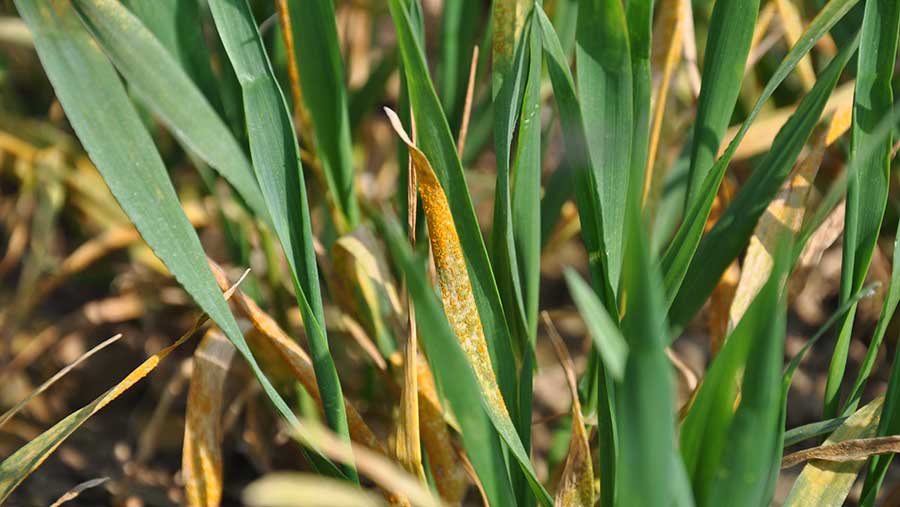 Rust in crop © Syngenta
Rust in crop © Syngenta Minimising the green leaf area lost to disease is critical for yield protection. The T1 fungicide plays a vital role in this, not only for managing Septoria, but also for controlling diseases such as yellow rust, which can escalate quickly.
Syngenta’s Joe Bagshaw offers five tips.
1. Don’t underestimate the importance of T1
Clearly, the flag leaf in winter wheat contributes the most to yield, at about 43%, while leaf 2 below contributes another 23%, says Joe.
But while leaf 3 below that – which is the spray target for T1 – contributes only about 8%, its significance is far more important than its yield contribution alone, he says.
“This is because leaf 3 is essentially a ‘stepping stone’ for foliar disease in the base of the crop to move up onto the important higher leaves,” Joe explains.
“An effective T1 fungicide provides a ‘firebreak’ to restrain this upward spread. Get it right and you stand to keep the crop in a much healthier position, and to get better results from your T2 fungicide because you’ll be applying it more preventatively. Get it wrong, and you can end up chasing disease for the remainder of the season.”
Joe says a common mistake if there appears to be little visible disease at the time of spraying is to excessively trim T1 fungicides back. However, he says it is important to remember that T1 is not solely about controlling disease already present, but also about protecting the crop against future disease pressure.
“History shows that the weather can quickly turn more favourable to disease after T1. Yellow rust, for example, can go through its life cycle faster than Septoria tritici in suitable conditions. Also, if T2 spraying is delayed, having a good T1 foundation can buy you a bit more time.”

The aim of the T1 fungicide is to hold back the spread of disease up the crop, says Joe Bagshaw © Syngenta
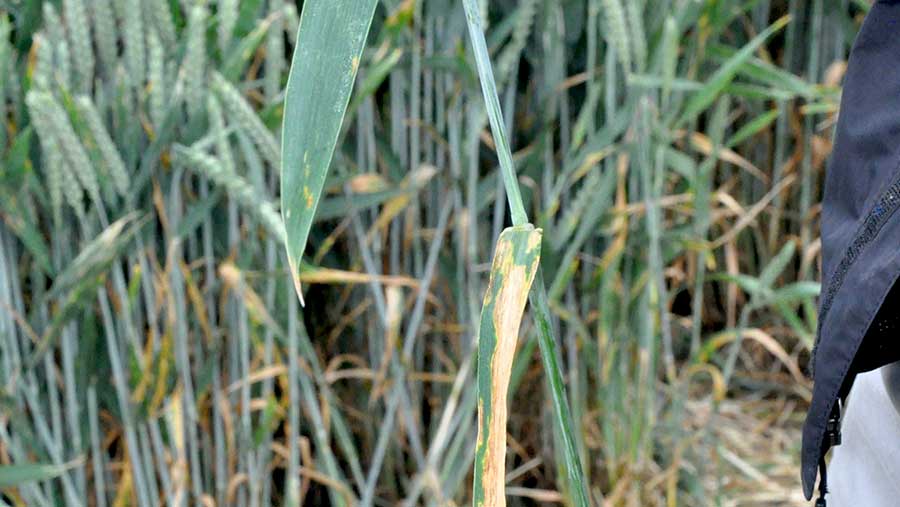
Clean flag leaf versus infected leaf © Syngenta
Find out more about successful disease management.
2. Spray at the correct growth stage
As well as choosing appropriate fungicide chemistry, a key part of a successful T1 is applying it at the correct growth stage, says Joe. The optimum is leaf 3 fully emerged and leaf 2 just tipping, he explains.
“If T1 is applied late, it can mean infection has already established on leaf 3, which will be difficult to eradicate.
“If applied too early, the lower part of leaf 3 won’t have fully emerged, leaving this part without full protection. On top of that, the interval between T1 and T2 will be stretched, and the T1 fungicide could run out of steam.
“To check that it is leaf 3 that is being sprayed, select a representative sample of wheat plants from around the field, cut open the stems, and count back the leaves from the developing ear.”
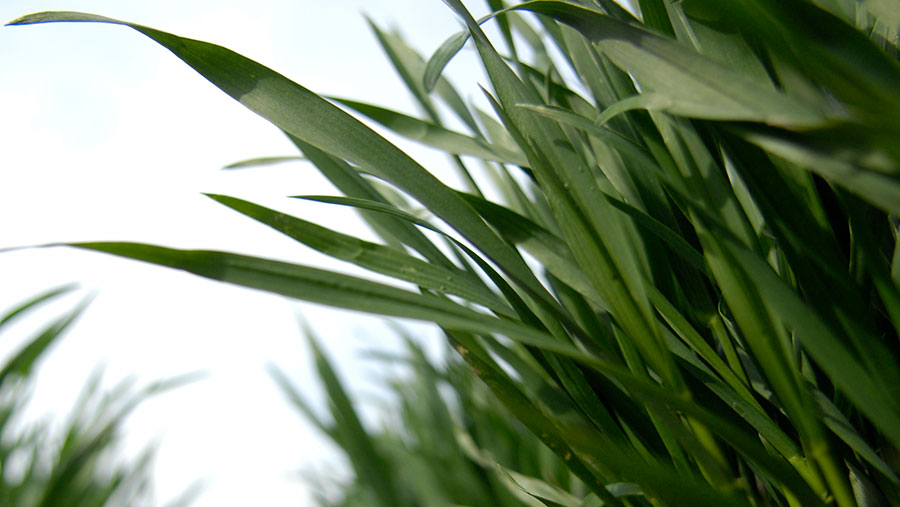
© Syngenta
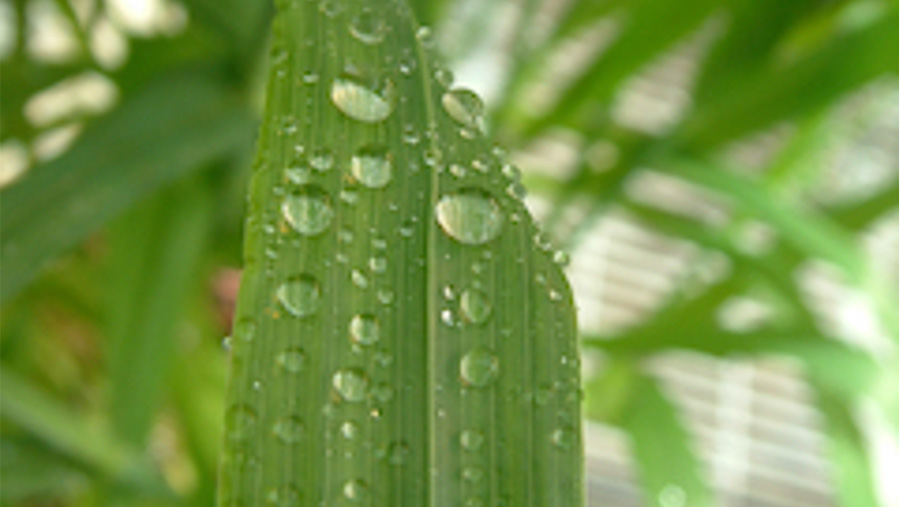
Timely spraying can be aided by nozzle choice, says Joe © Syngenta
3. Get application right
Joe explains that with the growth habit of wheat plants changing from prostrate at T0 to more upright at T1, it is important that nozzle choice is adapted for optimum coverage.
He says: “Consider Amistar nozzles at T1 with a water volume of 100 l/ha and at a height of 50cm above the target. However, always check what is suitable for the product being applied.
“The slightly rearward-facing spray produced by Amistar nozzles helps to counter the forward motion of the sprayer for more even coverage on the front and back of upright leaves. Amistar nozzles are also 75% drift-reduction nozzles when used at low pressures. Alternatively, the 3D90 nozzle can help to open up more spray days to maximise the chance of timely spraying.
“In very thick crops, a higher water volume might help canopy penetration. However, avoid simply increasing the spray pressure to achieve this as finer droplets will be more prone to drift.
“If drift reduction becomes particularly important, consider 90% drift reduction nozzles, but with a minimum of 200 l/ha of water to maintain coverage.”
See more Syngenta application guidance.
4. Control yellow rust early
Although protecting against Septoria is often a key aim at T1, it is important not to overlook yellow rust, Joe stresses.
“Yellow rust can flare up rapidly and cause yield losses of up to 50%. It’s also very unpredictable; variety resistance shouldn’t be relied on as things can change quickly. Plus, it’s a prolific producer of spores, which can travel for miles. Ifyou have active rust in the crop, make sure you control it early.”
Where yellow rust poses a risk, Joe says the SDHI-based fungicide Elatus Era is the clear choice at T1. “Not only does it offer protection against Septoria tritici, but AHDB dose response curves demonstrate that its SDHI component Solatenol (also known as benzovindiflupyr) has given outstanding yellow rust control, and outstanding yields in yellow rust situations,” he explains.
“Elatus Era is also highly cost-effective. This makes it financially easier to include the multi-site fungicide folpet in the T1 tank mix. Not only is folpet valuable for resistance management and extra protection against Septoria tritici, but also because it has given improved yield.”
See the multi-year yellow rust performance of Solatenol (referred to as Elatus Plus) in AHDB dose response curves (opens as PDF).
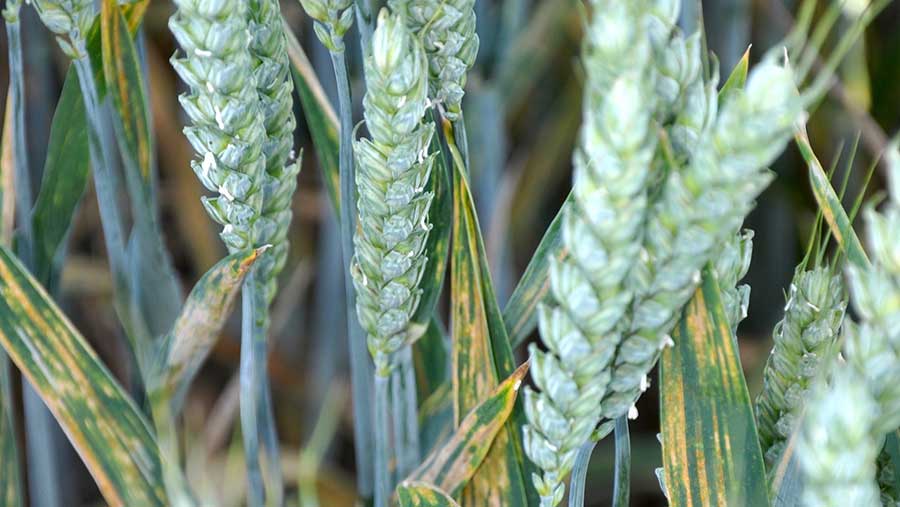
The last thing you want with yellow rust is for it to reach the flag leaves, says Joe Bagshaw © Syngenta
5. Look for long-lasting protection
Given that a key role of T1 is to slow down the spread of disease to higher yield-building leaves, another important feature of a T1 fungicide is that it provides long-lasting protection, says Joe.
In part, he says this is influenced by how the fungicide interacts with the leaf. “While some fungicides move upwards slowly in leaves, others move more rapidly. A concern with faster movement is that the fungicide accumulates towards the leaf tip, leaving the parts of the leaf towards the base less well protected.
“Solatenol, on the other hand, moves relatively slowly and has been found to produce an even distribution of fungicide along the leaf length. As well as complete leaf protection, this contributes to its long-lasting results.
“Ultimately, the longer the crop can be kept clean of disease from a T1 application, the better the yield protection, plus the less pressure that is placed on the newer fungicide chemistry, such as Miravis Plus + Era, that’s used at T2. So it’s a win-win.”

The longer the crop can be kept clean of disease from a T1 application, the better the yield protection, says Joe © Syngenta
ELATUS® Era, ELATUSTM Plus, MIRAVIS® Plus, EraTM and the Syngenta logo are trademarks of a Syngenta Group Company.
ELATUS® Era (MAPP No. 17889) contains benzovindiflupyr and prothioconazole. ELATUSTM Plus (MAPP No. 17841) contains benzovindiflupyr. MIRAVIS® Plus (MAPP No. 20847) contains pydiflumetofen. EraTM (MAPP 19792) contains prothioconazole.
All other brand names used are Trademarks of other manufacturers in which proprietary rights may exist.
Use plant protection products safely. Always read the label and product information before use.
For further product information refer to www.syngenta.co.uk
Provided by
Syngenta is one of the world’s leading agricultural companies, comprising of crop protection and seeds. Our ambition is to safely help feed the world while taking care of the planet.
